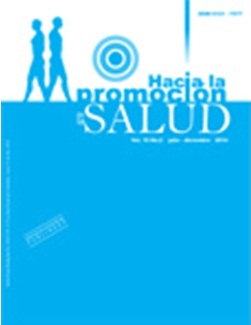Authors
Abstract
Objective: To identify the knowledge and some practices related with pedestrian safety in fifth graders from public educational institutions registered in 2009 in the urban area of Manizales. Material and method: Quantitative, descriptive type research; target population: 4,831 fifth grade students, both male and female, from 44 public educational institutions in the urban area of Manizales. Probability sampling with a reliability margin of 95%, error margin of 5%, estimate percentage of 70%, for a 336 students sample using the statistics program Stast was found. Results: Students between 10 and 14 years of both sexes (DE=2,41, media 10,10 years) from low socioeconomic status. 89% of the population studied had social security at the time of the study. From the total participants (n = 336), 84% were aware of the traffic signs related to men working, the pedestrian walk away sign (81%), cyclists on the road (77%). What attracts the attention is that only 29% of the students knew the school zone signs and 44% knew the bus stop signs. As far as the road infrastructure is concerned, the students said that near their houses and schools there are few pedestrian crosses and pedestrian bridges. The teacher is the meaningful adult in the road safety learning after the parents. They considered damaged or turned off traffic lights as the most dangerous situations to cross a street, followed by the absence of traffic lights. They prefer to play on streets close to their houses because of the absence of parks where to play. Conclusions: because of their condition as students, the participants in the study expose themselves several times during the day to the danger of crossing streets. The lack of sufficient road infrastructure including pedestrian crossings and pedestrian bridges, as well as damaged or turned off traffic lights is worrying. The conceptions and what underlies in some urban contexts students pedestrian practices are a strategy to have a bearing on inclusive public policies for citizen education from the perspective of health promotion, human security, respect, responsibilities and rights of pedestrians.
References
Duperrex O, Roberts I, Bunn F. Educación de peatones en temas de seguridad para la prevención de lesiones (Revisión Cochrane traducida). En: La Biblioteca Cochrane Plus, número 4, 2007. Oxford, Update Software. [fecha de acceso 15 Jul 2010]. Disponible en URL: http://www.update-software.com
Garoz PI. El desarrollo de la conciencia de regla en los juegos y deportes. Revista Internacional de Medicina y Ciencias de la Actividad Física y el Deporte [en línea]. 2005. [fecha de acceso 15 Jul 2010]; 5(19). Disponible en URL: http://cdeporte.rediris.es/revista/revista20/artconciencia.htm.
Celis A, Gómez Z, Martínez-Sotomayor A, Arcila L, Villaseñor M. Family characteristics and pedestrian injury risk in Mexican children. Injury Prevention 2003; 9:58-61.
Stevenson M, Jamrozik KD, Spittle J. A case control study of traffic risk factors and child pedestrian injury. Int J Epidemiol 1995; 25:957-964.
Alcaldía de Manizales. Últimas noticias. [en línea].2010. [fecha de acceso 13 Jul 2010]; Disponible en URL: http://www.alcaldiamanizales.gov.co/es/servicios-de-informacion/987-desde-manana-eltransito-sera-una-nueva-materia-en-el-instituto-universitario-
Plan de Desarrollo 2008-2011 Manizales: Ciudad Internacional de Conocimiento con Oportunidades para todos. Área social Sector salud. Desarrollo urbano sostenible. Políticas Transversales; 2010.
Colombia. Código Nacional de Tránsito Terrestre. Ley 769 de agosto 6 de 2002.
Organización Mundial de la Salud. Informe sobre la situación mundial de la seguridad vial: es hora de pasar a la acción Ginebra, 2009 [Citado el 29 de septiembre de 2009] Disponible en: http://www.who.int/violence_injury_prevention/road_safety_status/2009).
Rodríguez DY, Fernández F, Acero H. Road traffic injuries in Colombia. Injury Control and Safety Promotion 2003; 10(1, 2) pp.29-35.
Policía de Carreteras, SIAT, INVIAS, Instituto Nacional de Medicina Legal y Ciencias Forenses. Fondo de Prevención Vial 2007 [citado 10 Jun 2008]. Disponible en URL: www.fonprevial.org.co/index1
Instituto Nacional de Medicina Legal y Ciencias Forenses. Forensis. Datos para la vida. Muertes y lesiones por accidentes de tránsito. Bogotá: 2009.
Dirección Territorial de Salud. Caldas Informe de Gestión 2007. Manizales: Dirección Territorial de Salud; 2008.
Secretaría de Tránsito y Transporte Manizales. Informe de Gestión 2007. Manizales: Secretaría de Tránsito y Transporte; 2008.
Fondo de Prevención Vial 2008 Estadística y accidentalidad. Accidentalidad vial en Colombia 2007 [Citado 10 Jun 2010]. Disponible en URL: www.fonprevial.org.co/
Roberts I, Norton R, Jackson R, Dunn R, Hassall I. Effect of environmental factors on risk of injury of child pedestrian by motor vehicles: a case control study. BMJ 1995; 310: 91-4.
Tester J. Rutherford G. And matched case-control study evaluating the effectiveness of speed humps in reducing child pedestrian injuries. American Journal of Public Health 2004 Abril; 94 (4).
Echeverry A, Mera JJ, Villota J, Zárate LC. Actitudes y comportamientos de los peatones en los sitios de alta accidentalidad en Cali. Colomb Med 2005 June; 36 (2):79-84.
Cabrera G, Velásquez N, Valladares M. Seguridad vial un desafío de salud pública en la Colombia del siglo XXI; 2009.
Mockus A. Armonizar ley, moral y cultura. Cultura ciudadana, prioridad de gobierno con resultados en prevención y control de violencia en Bogotá, 1995-1997
Perdomo R. Accidentes de tránsito en la adolescencia. [en línea].Uruguay. Querencia. [serie en internet]. 2001 abril [Citado 21 julio 2010];(2). Disponible en: http://www.querencia.psico.edu.uy/revista_nro2/rita_perdomo.htm
Cook BS, Ricketts CD, Brown RL, Garcia VF, Falcone RA. Effect of safety education on classmates of injured children: A prospective clinical trial. J Trauma Nurs 2006; 13(3):96-101.
Turner C, McClure R, Nixon J, Spinks A. Community-based programmes to prevent pedestrian injuries in children 0-14 years: A systematic review. Inj Control Saf Promot 2004; 11(4):231-237.
Fiorentino J, Blidner J. Los niños y el tránsito. [en línea]. Argentina. [citado 30 julio de 2010]. Disponible en: http://www.paideianet.com.ar/los_ninos.htm


 PDF (Español)
PDF (Español)
 FLIP
FLIP






















